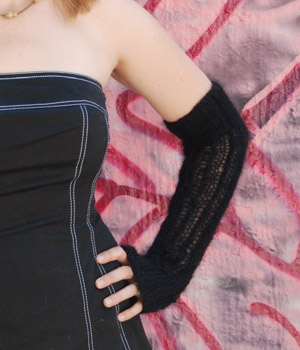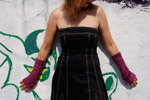

 |
Beltane 2010 |
 |
 |
 |
creeping jenny > nettled > lady macbeth

Katie Rose Pryal (model)
Michael Pryal (photo)
Lady Macbeth was the bewitched and bewitching wife of the Scottish King Macbeth. She truly was the power behind the throne, and she got some of the best lines:
To beguile the time,
Look like the time; bear welcome in your eye,
Your hand, your tongue: look like the innocent flower,
But be the serpent under't.
—Shakespeare, Macbeth, Act I, Scene 5
These lacy, long Lady Macbeth arm warmers are both the innocent flower and the serpent under it: they are soft and warm, and the cobweb lace pattern gives them a good dose of dark magic.
Suggested Reading
Difficulty
Strong Intermediate
Click here for definitions of difficulty levels.
Finished Measurements
XS [S, M, L]: See Design Notes for help determining your size.
Circumference of cuff = 5.5"/14cm [6.5"/16.5cm, 8"/20.3cm, 9.5"/24.2cm].
Designed for 3-4"/7.5-10cm of negative ease.
Length should be custom fit to you.
Materials
- Bollicine Etoile [70% kid mohair, 30% acrylic; approx. 164yd/150m per 1.25oz/50g skein] black, 1 skein
- Two US size 5/3.75 mm circular needles, length unimportant
- Two US size 7/4.5 mm circular needles, length unimportant
- Flexible measuring tape
- Stitch markers
- Tapestry needle
Gauge
20 sts and 20 rows = 4"/10cm in 2x2 ribbing, unstretched.
Design Notes
Yarn Substitutions: 150m of any medium weight mohair yarn will do.
Lady Macbeth packs a lot of technique into a small package: one skein of yarn and one weekend are all you need to make a pair. This pattern is a great introduction to lace work, with a simple 4-stitch, one-row repeat designed for working in the round. Plus, Lady Macbeth requires no seaming and is knit from the top down, so you can try them on as you go. This is also a great way to learn the double-circular method of knitting in the round. For a tutorial in the double-circular method, check out KnittingHelp.com
The cuffs are worked in k2, p2 rib. The main body of the arm warmer is worked in lace. I have dubbed the lace stitch "Cobweb Lace" and the stitch pattern is described in the directions. The lower cuff has a simple hole for the thumb.
For those of you who live in warmer climates, or need a little less serpent, these can be worked as shorter wrist warmers. And because this pattern is blissfully flexible, there are also instructions for leg warmers.
To determine your size, measure the circumference of your upper arm above the elbow (for arm warmers), forearm (for wrist warmers) or calf (for leg warmers). Subtract 3 inches/7.5 cm from your measurement to allow for negative ease. Match this number with a cuff size from "finished measurements," above.
Lace Work Suggestions:
I recommend knitting this lace pattern loosely, to make the p2togs easier on subsequent rounds.
The knit stitches in the lace pattern should line up with those of the round below. This can help you make sure that your stitch count is correct.
The most common challenge with this lace pattern is a forgotten YO on the previous round. Instead of ripping back to the mistake, pick up a stitch from the round below where the YO should be, and knit that stitch, being careful not to twist it. This is a m1 increase without the twist, which leaves a hole.
Remember, Lady Macbeth was a little bit crazy; it's okay if your arm warmers are a little crazy too.
First, measure the length of your forearm from the outer bend in elbow to base of thumb in inches or centimeters. The pattern refers to this as your "forearm measurement."
Upper Arm Cuff (or Forearm Cuff if making wrist warmers)
Using smaller needles, CO 32 [40, 48, 56] sts. Divide evenly across 2 circulars. Place marker to indicate beginning of round. Join, being careful not to twist stitches.
Using double-circular method for working in the round, work in k2, p2 rib for 28 rounds. Begin Cobweb Lace section.
Cobweb Lace Pattern
Switch to larger needles.
Rnd 1: *K1, yo, sl1-p2tog-psso, yo* rep. until 4 sts remain on first needle. k1, yo, p2, yo, k1. Repeat this process across second needle (34 [42, 50, 58] sts.)
Rnd 2: *K1, yo, sl1-p2tog-psso, yo* rep. until 1 st remains on first needle, k1. Repeat this process across second needle.
Repeat round 2 until the length of the lace section of work equals your forearm measurement.
Wrist Cuff and Thumb Opening
Switch to smaller needles.
Rnd 1: Work in k2, p2 rib until 3 sts rem on first needle, p2tog, p1. Repeat for second needle (32 [40, 48, 56] sts.)
Rnd 2: Work in k2, p2 rib.
Rnds 3-6: Repeat rnd 2.
Rnd 7: K2, BO 3 sts, work rib patt to end of round.
Rnd 8: K2, CO 3 sts, work rib patt to end of round.
Rnd 9-28: Continue to work in k2, p2 rib.
Bind off in k2, p2 rib stitch.
For Leg Warmers
Measure the circumference of your calf where you will want the legwarmer to sit, subtract 3-4"/7.5-10cm for negative ease, and select your size. Usually it is one size larger than your size for the long arm warmers.
Measure the distance from the bottom of your kneecap to the top of your foot—this is the total length of the project. Subtract 8"/20cm for the top and bottom cuffs, and this measurement is the length of the lace you should work—your "leg measurement."
Now, work this pattern as for the long arm warmers, substituting your "leg measurement" for the "forearm measurement" above.
Work the bottom cuff without the thumb opening.
Bind off in pattern.
Make these in the a super-fuzzy mohair for extra warmth!
Finishing
Weave in ends. Block if desired.
About
 contact Katie:
• http://knittyprofessors.com • legal info
contact Katie:
• http://knittyprofessors.com • legal info
![]()
home • antifesto • archive • errata • masthead • angstylvania • legal

